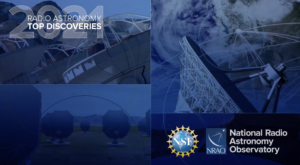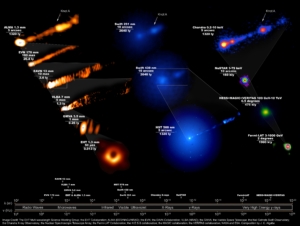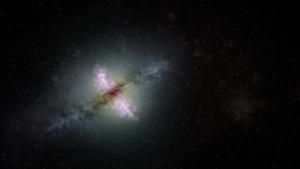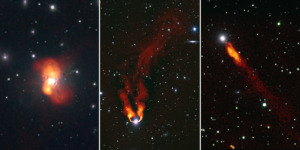The formation of massive stars and planets. The deaths of stars and galaxies. The extreme and violent behaviors of black hole jets and quasars. An up-close and personal radar view of the Moon. These mysteries and more were unraveled in 2021 by radio astronomers leveraging the scientific and technological power of National Radio Astronomy Observatory (NRAO) facilities.
VIDEO: Multi-wavelength Observations Reveal Impact of Black Hole on M87 Galaxy
New multi-wavelength observations mounted by the Event Horizon Telescope (EHT) collaboration across the entire electromagnetic spectrum have provided new insight into the impact of the black hole at the core of galaxy M87 on its immediate, and not so immediate, surroundings.
Quasar Discovery Sets New Distance Record
Astronomers using the Atacama Large Millimeter/submillimeter Array (ALMA), along with other telescopes, have discovered the most distant quasar yet found. The bright quasar, powered by a supermassive black hole at the core of a galaxy, is seen as it was only 670 million years after the Big Bang, and is providing valuable clues about how such huge black holes and their host galaxies formed in the early Universe.
VLA Sky Survey Reveals Newborn Jets in Distant Galaxies
Comparing data from VLA sky surveys made some two decades apart revealed that the black hole-powered “engines” at the cores of some distant galaxies have launched new, superfast jets of material during the interval between the surveys.
IMAGE RELEASE: Galaxies in the Perseus Cluster
New VLA images show how the crowded environment of a cluster of galaxies affects the individual galaxies, helping astronomers better understand some of the complex details of such an environment.
NRAO Contest Winners Illustrate Diverse Cosmic Phenomena
Winners in NRAO’s VLA 40th Anniversary Image Contest are from around the world, and their works illustrate a fascinating variety of celestial objects. Entries combined observational data from the VLA with data from optical, infrared, and X-ray telescopes, and from computer simulations.











